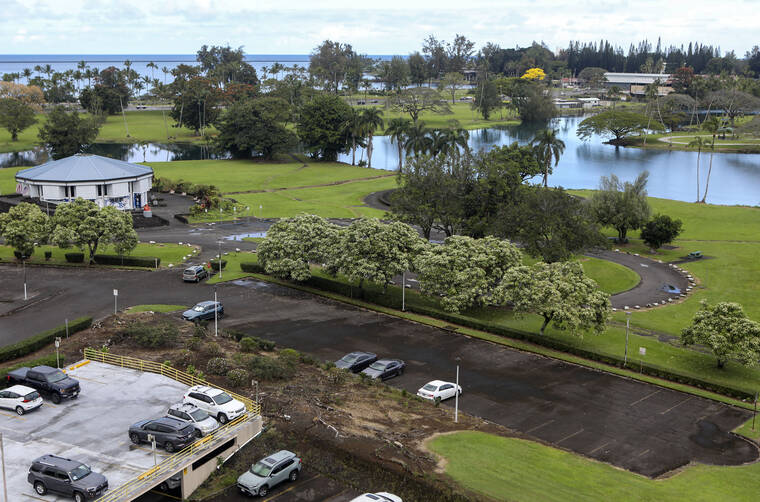‘Safe Space’ draws concerns: Residents, lawmaker worried about impact of homeless camp on area
HILO, Hawai‘i — A state lawmaker has joined some Hilo residents in their concerns about a planned government-sanctioned homeless encampment near the Hilo Lagoon Center.
In February, residents and owners at the center became aware of a plan by state and county officials to establish a “Safe Space” for homeless individuals on a parking lot near the Wailoa River State Recreation Area, sandwiched between the State Building and the Hilo Lagoon Center, and immediately south of the Wailoa Art Center.
The project would be a part of Hawai‘i County’s Safe Space initiative, a plan to establish semi-permanent areas where homeless people can congregate without being subject to forcible removal by authorities.
It would expand the state Office on Homelessness and Housing Solutions’ kauhale initiative, which develops communal living spaces of tiny homes to provide affordable transitional housing for homeless people.
While county officials said in February that no sites for such spaces have been finalized, the parking lot by the Hilo Lagoon Center has been discussed as a possible location. However, residents have criticized the choice for a variety of reasons, and Hilo Rep. Richard Onishi has echoed those concerns.
“The initial concerns were that the governor’s office, and the county didn’t reach out to people in the area,” Onishi told the Tribune-Herald. “I didn’t know about it either until residents told me about it. … And it concerns me, because I have my own initiatives planned for improvements to the (Wailoa) park, the Vietnam memorial and the art center.”
Onishi said the center’s residents have valid concerns about both the impacts of a homeless camp on the surrounding area, and the potential health impacts from people sheltering there long term.
At a meeting Monday of Hilo Lagoon Center property owners, owner Brian Sanders said the Wailoa River has a history of both containing toxins and flooding, and presented data from the University of Hawai‘i demonstrating that soil samples taken from near the parking lot in question had high levels of arsenic and lead.
That data showed arsenic levels more than three times higher than the state Department of Health’s acceptable background level.
The parking lot also is still located within Hilo’s tsunami evacuation zone.
“We’re up here on a high floor, so we feel safe if there’s a tsunami,” said Dave Rocha, an owner at the center. “But if there’s a whole community down there that might not have time to get out … To be sitting up here and watch a tsunami wipe out a whole group of people would be devastating.”
But Rocha also said the location seems inconsiderate of Hilo Lagoon Center residents.
“It would disrupt the tranquility of the whole area,” Rocha said. “It’s installing a whole community we know nothing about 20 feet from our parking and 30 feet from our building.”
At Monday’s meeting, Sanders said rumors have pegged the planned size of the encampment at about 20 tiny home units, which might be served by portable toilet facilities and generators.
Onishi said that matches what he has heard about the planned project.
“It’s not so bad if it’s temporary,” Onishi said. “But I have no idea as to how long they could be there. It could be two to three years, even.”
Sanders was frustrated that details remain vague, and criticized the state and county for not engaging with community members about the project.
He speculated that John Mizuno, administrator at the Statewide Office on Homelessness and Housing Solutions, intends to force the project through quickly before any local opposition can organize, and said that a meeting of the Hawai‘i Interagency Council on Homelessness the previous week had shut down any public comment about the project.
But Onishi added he believes the camp is far from a done deal, saying that he is working with Mizuno and county Housing Administrator Susan Kunz to explore alternate locations.
“I think it’s still a tentative location,” Onishi said. “I think it definitely can be changed.”
Kunz did not respond to the Tribune-Herald’s requests for comment.
Rocha said he hopes a planned future meeting between residents and representatives of Gov. Josh Green will convince officials to seek out other locations.
“I hope we can convince the governor to take a second look,” Rocha said. “It’s not to say that we own the area, and people have a right to have a place to live, but to drop it in our lap like this. …. I want them to hear our concerns, but if this gets built and something bad happens, the governor is going to have to take responsibility.”
For his part, Mizuno issued a statement on Wednesday confirming his office is investigating possible kauhale sites in Hilo and Kona in partnership with Mayor Mitch Roth.
“We will continue our due diligence on possible kauhale sites while engaging with the communities for their input,” Mizuno said in the statement. “We will continue to focus our efforts to reduce homelessness, reduce crime, reduce recidivism and reduce taxpayers’ costs.”
•••
Reporter Michael Brestovansky can be reached at mbrestovansky@hawaiitribune-herald.com.

